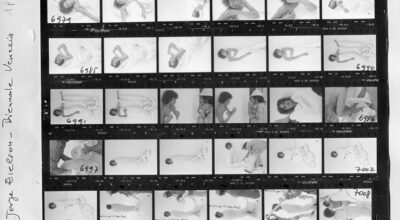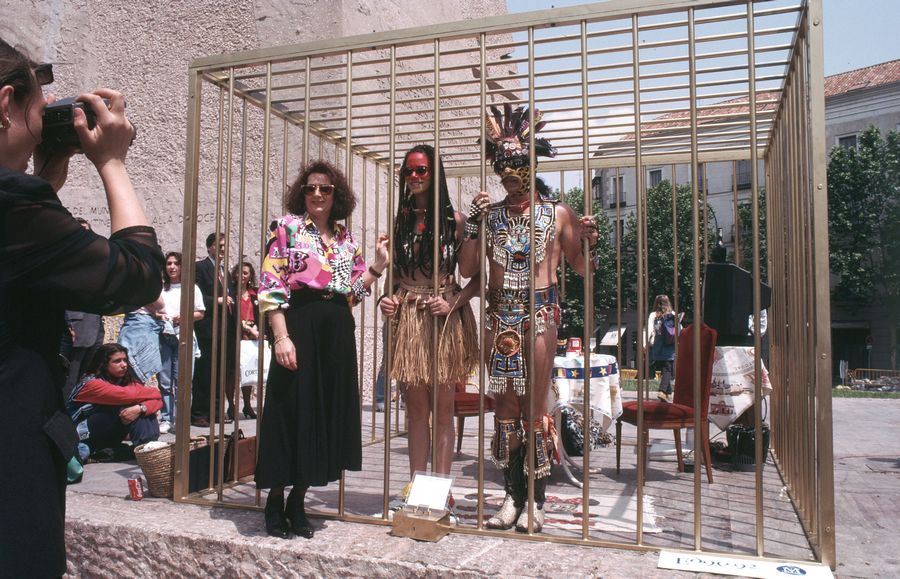
COCO FUSCO: TOMORROW, I WILL BECOME AN ISLAND
Tomorrow, I Will Become an Island at the KW Institute for Contemporary Art is the first major retrospective of Cuban-American artist Coco Fusco (b. 1960, US). For more than three decades, she has been a key voice in discourses on racial representation, feminism, postcolonial theory, and institutional critique.
The exhibition seeks to trace the profound influence that Fusco’s work has had on contemporary art discourses in the Americas and Europe. To do so, it features a broad selection of the artist’s videos, photography, texts, installations, and live performances from the 1990s to the present day.
With her multidisciplinary practice, Fusco explores the ways that intercultural dynamics affect the construction of the self and ideas about cultural otherness. Her work is informed by multicultural and postcolonial discourses as well as feminist and psychoanalytic theories.
Her investigation of intercultural dynamics has led her to develop art projects about ethnographic displays, animal psychology, sex tourism in the Caribbean, labor conditions in free trade zones, suppressed colonial records of Indigenous struggles, and the military interrogation techniques used in the war on terror.
Her more recent work focuses on the relationship between poetry and revolutionary politics in Cuba. The exhibition is loosely structured along these various interconnected themes. As such, Tomorrow, I Will Become an Island shows the breadth of Fusco’s artistic practice that is highly relevant considering current political and cultural debates in Germany and beyond.
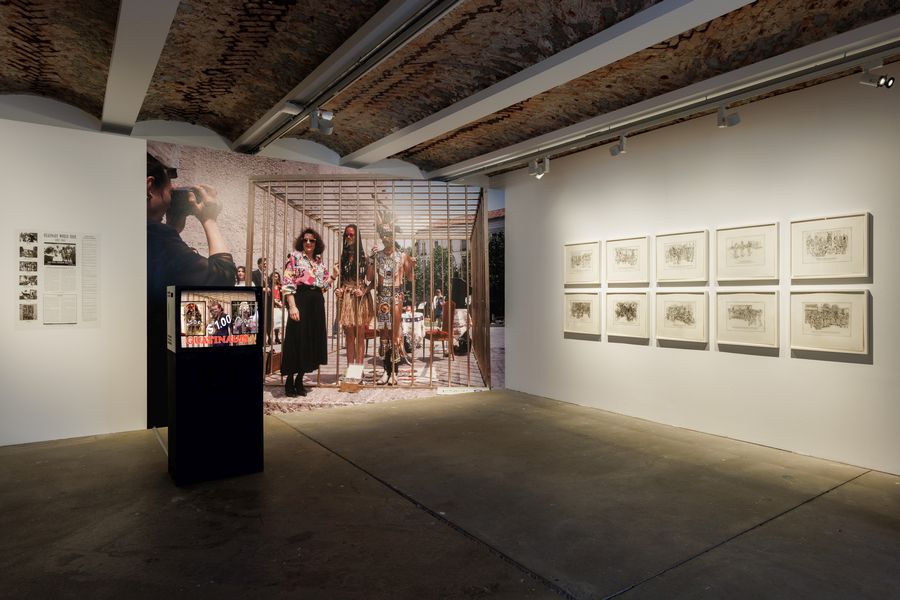
COUPLE IN THE CAGE
Between 1992 and 1994, Coco Fusco and Guillermo Gómez-Peña staged Two Undiscovered Amerindians Visit the West, with which they traveled to art and natural history museums and public squares in the US, Europe, Australia, and Argentina.
The performance was a creative investigation of the ethnographic display of Africans, Asians and Latin Americans that had taken place over five centuries in European and American zoos, parks, world fairs, and museums.
Confined in a cage, Gomez-Peña and Fusco presented themselves as “undiscovered Amerindians” from the fictitious island Guatinau in the Gulf of Mexico. Dressed in kitsch versions of Indigenous clothing, they engaged in so-called “traditional” Guatinaui tasks: watching television, sewing voodoo dolls, using a laptop, pacing, and accepting fruit fed to them by docents.
Signage that featured a map of their island provided the audiences with information about their presumed origins. Docents took them to the bathroom on leashes and took polaroids of audience members that chose to pose with the performers.
Responses to the now-renowned performance ranged from believing that Fusco and Gómez-Peña were real so-called “savages,” to taking offense at the sight of caged human beings, to denouncing the performance as inhumane and shocking.
The wide range of responses became a central component of the performance, affording anthropological insight into colonial fantasies about the existence of so-called “primitive” societies that many people still believe in.
Reflecting on the resonance of the performance, Fusco has stated that: “Uneasiness was a better response to the persistence of race as a social fact than disbelief or disinterest.”1 For thirty years, experts and students worldwide have scrutinized the records of Two Undiscovered Amerindians, attesting to its continuous relevance.
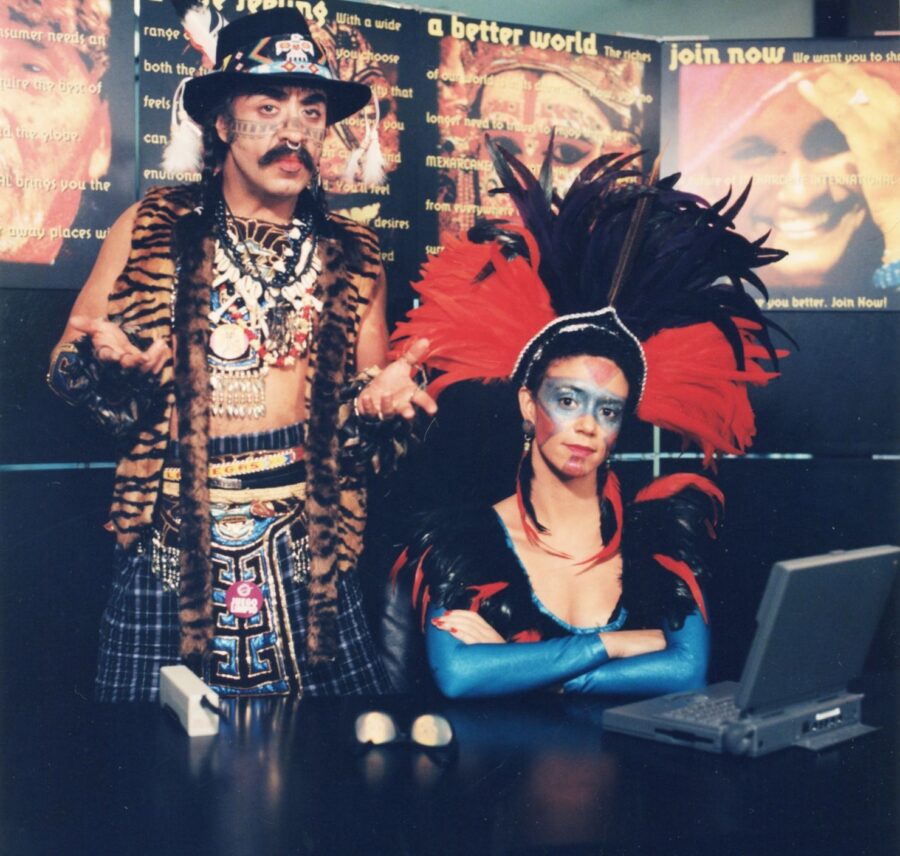
THE EARLY PERFORMANCES
Performance has been pivotal to Fusco’s work as way to dramatize the effects of cultural appropriation and commodification, and reveal how objectification, exoticization and eroticization of the “other” pervade seemingly innocent social relations.
Fusco has carried out performances in art institutions and theaters, as well as guerilla performances in art fairs and public spaces. According to Jill Lane, associate professor Spanish and Portuguese at New York University: “(…) Fusco suggests that performance art is especially suited both to index and critique the histories of racial and gender violence that have been deeply coded into the ways we both inhabit and interpret the physical body.”2 On display in the exhibition are traces of a selection of Fusco’s earlier performances.
Together with Guillermo Gómez-Peña, Coco Fusco also conceived Mexarcane International (1994–95), which was staged in shopping malls, to show how colonial fantasies persist in contemporary consumer culture. Pretending to be representatives of a multinational corporation marketing “exotic” talent, they conducted parodic surveys about desires for the “exotic” and performed non-sensical representations of non-Western cultures.
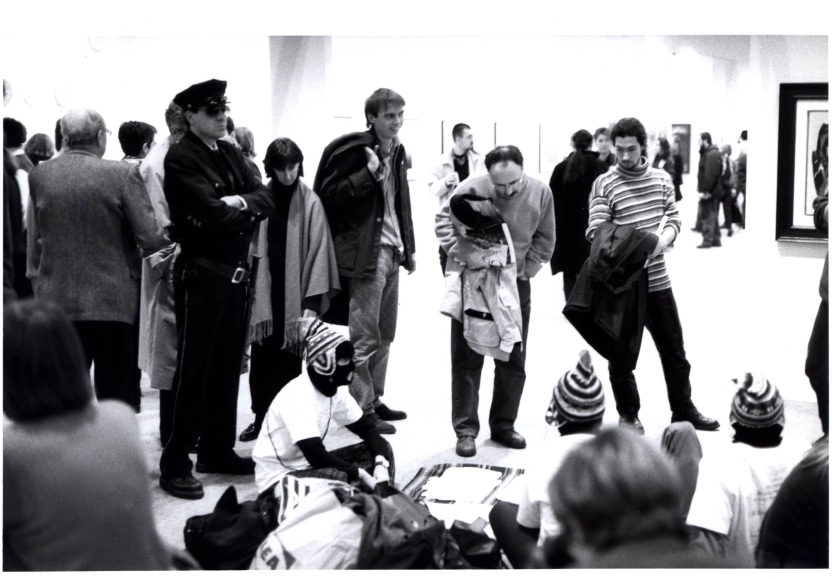
In the guerilla performance Sudaca Enterprises (1997), Fusco entered ARCO art fair in Madrid together with Juan Pablo Ballester and María Elena Escalona, dressed in ski masks and Quechua knit hats. Sudaca is a derogatory term used in Spain to refer to Latin Americans meaning “dirty southerner.”
The artists sold t-shirts with a text that compared the cost of importing and selling Latin American art at ARCO with the economics of survival for undocumented Latin American immigrants in Spain.
The artists reclaimed the term to emphasize the double standard perpetuated by the fair that had just started a new focus on art from Latin America at the very moment that Spanish immigration policies made it increasingly difficult for people from these countries to attain a visa.
Over three days, the artists were removed several times by security, but they nevertheless managed to sell all their t-shirts.
Also in 1997, Fusco performed Rights of Passage at the second and last Johannesburg Biennale. Dressed as a South African policewoman and working with South African theater students playing guards, Fusco set up a checkpoint at the entry of the biennial’s main building and required visitors to obtain passbooks modeled on the documents that Black South Africans were required to carry during Apartheid.
These passbooks regulated their movement outside townships and documented whether they had permission to carry arms. They were a key symbol of the Apartheid system. The sentence “Stop! Do you have your pass?” voiced in Afrikaans by the guards greeted the visitors upon entrance as they were asked to provide details about their name, nationality, ethnicity, etc., and required to have their passbooks stamped before entering the biennial exhibits.
Fusco allowed audience members to be creative regarding the information in their passbooks and produced documents for imaginary beings or body parts. On the one hand, Rights of Passage raised questions about race, space, and institutional power in the post-Apartheid era. On the other hand, it was a comment on present-day cultural tourism and how horrifying historical occurrences can become a point of attraction and capital investment.

Fusco’s performance Stuff, which she created in collaboration with the artist Nao Bustamante, continued her commentary on globalization, tourism, and sexism. With it, the artists toured numerous institutions and theaters in the US and Europe between 1996 and 1999.
Stuff looked at the cultural myths that link Latin women and food to the erotic in Western popular imagination, where food served as a metaphor for sex and eating represented consumption in its most grim form.
For the photo series Paquita y Chata se arrebatan (1996), Fusco and Bustamante performed as live versions of popular Mexican Lupita dolls, papier-mâché representations of prostitutes that signaled a wife’s awareness of her husband’s infidelity.

MILITARY INTERROGATION
Between 2005 and 2009, at the height of the war on terror, Coco Fusco developed a body of work that investigated the use of female sexuality as a weapon in the military interrogation of Muslim men in Iraq, Afghanistan, and the US base at Guantánamo.
She was deeply disturbed by the images of the abuse of prisoners in Abu Ghraib by American military police and noted that many women were involved. This led her to conduct research into the role of women in the US military, and to conceive of military prisons as staging groups for intercultural encounters.
Fusco based the performance Bare Life Study #1 (2005) on the US military’s forms of punishment. She learned that it was a common practice to discipline soldiers and prisoners by making them clean cells and hallways with toothbrushes for hours.
Fusco reenacted the scene with a group of fifty performers that knelt and cleaned the street in front of the US consulate in São Paulo with toothbrushes, while diplomatic personnel watched.

For Operation Atropos (2006), Fusco invited six other women to participate with her in a workshop led by former US military interrogators for people in the private sector to learn how to survive as a prisoner of war.
The course involved an immersive simulation in which the workshop participants played prisoners and were subjected to harsh interrogations, followed by a class in which the participants were encouraged to try to interrogate their teachers.
The video depicts the group experiencing the challenging questioning and its physical and psychological effects. The theorist José Esteban Muñoz observed among others about this work: “These counter-performances do more than simply reject the dominant national performance that shores up power at this particular historical moment. (…) Instead, Fusco replicates the performance of power in an attempt to understand its dimensions and larger social repercussions.”3
More interrogation techniques are depicted in the illustrations A Field Guide for Female Interrogators (2006), a collaboration between Fusco and illustrator Dan Turner that accompanied her eponymous 2008 publication. Based on actual accounts of US military interrogation tactics, the series raises moral questions about these techniques in general and the use of female sexuality in as a weapon of war.


POST-REVOLUTIONARY CUBA
Through her art, activism and writing, Fusco has elaborated an extended critique of the romantic views of the Cuban revolution that persist in Europe and America three decades after the end of the Cold War.
She has collaborated with Cuban artists on the island and in the diaspora since the 1980s. After Fidel Castro stepped down from power in 2008, she began to work on a series of videos that explore the relationship between culture and politics in Cuba and to focus on key conflicts between artists and the Cuban state from the 1960s to the present. A large selection is presented in KW’s main hall.
In The Empty Plaza (2012), Havana’s Plaza de la Revolución is the protagonist in Fusco’s meditation on public space, revolutionary promise, and memory. Inspired by the Arab Spring protests of 2011, Fusco asks why, in parallel, this square is left vacant.
In the four other videos, Fusco excavates the case of four poets who came into conflict with the Cuban state and were arrested, imprisoned, and in exile. Their works were banned on the island. In focus are the stories of Heberto Padilla (The Confession, 2015), María Elena Cruz Varela (The Message in a Bottle from María Elena, 2015), Reinaldo Arenas (To Live in June with your Tongue Hanging Out, 2018), and Néstor Díaz de Villegas (The Eternal Night, 2022).
With this body of work, Fusco contributes to the collective efforts of dissident Cuban intellectuals and artists to narrate and share forbidden chapters of Cuban revolutionary history. Writer Antonio José Ponte states about this aim: “For all that’s been obscured and will return one day. And all that must still emerge. It is about an audience still to come, citizens for the emptied spaces in which Coco Fusco lingers, whether or not the authorities let her into Havana. Coco Fusco’s work exists for the audience still to come.”4
Along with the exhibition, KW Institute for Contemporary Art further honors the complexity and multidisciplinarity of Fusco’s writing, activism, and performative work with a varied public program. In addition to a series of talks, partly organized together with ICI Berlin, KW commissioned Fusco to create the new multimedia-performance Antigone Is Not Available Right Now, which is staged in collaboration with Sophiensaele early December 2023.
Parallel to the exhibition at KW, an extensive, eponymous monograph of Fusco’s work will be published by Thames & Hudson with contributions by Julia Bryan-Wilson, Anna Gritz, Jill Lane, Antonio José Ponte, and the artist herself.
Footnotes
1 Coco Fusco, “Still in The Cage,” Modern Painters (February 2012): 57.
2 Jill Lane, “Corporeality and Critique,” in Tomorrow, I Will Become an Island, ed. Olga Viso (New York: Thames & Hudson Inc., 2023), 37.
3 Coco Fusco and José Esteban Muñoz, “A Room of One’s Own: Women and Power in the New America,” TDR: The Drama Review 52, no. 1 (Spring, 2008): 137.
4 Antonio José Ponte, “Coco Fusco and the Empty Spaces of Havana,” in Tomorrow, I Will Become an Island, ed. Olga Viso (New York: Thames & Hudson Inc., 2023), 59.
Text by co-Curators Anna Gritz, Léon Kruijswijk
Assistant Curator: Linda Franken
Coco Fusco: Tomorrow, I Will Become an Island is on view through January 7, 2024, at KW Institute for Contemporary Art, Auguststraße 69, Berlin
También te puede interesar
ANUNCIAN ARTISTAS PARTICIPANTES EN MUESTRA DE LA 56ª BIENAL DE VENECIA
Hoy se anunció la lista de los artistas participantes en la exposición de la 56ª Bienal de Venecia, titulada All the World’s Futures (Todos los futuros del mundo), curada por el nigeriano Okwui Enwezor, entre los que se…
LA HISTORIA COMO RUMOR. PERFORMANCES DE MOVIMIENTO MÚLTIPLE
Malba presenta "La historia como rumor", un programa anual de exhibiciones online concebido por la directora Gabriela Rangel con el objetivo de documentar y contextualizar un conjunto de performances que ocurrieron en distintos momentos...
Mundos Alternos:art And Science Fiction in The Americas
"Mundos Alternos: Art and Science Fiction in the Americas" brings together the work of 30 international artists from across Latin America and the Caribbean, including Mexico, Cuba, Argentina, El Salvador, Brazil, Chile and Puerto...


